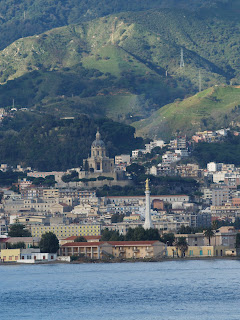Our ship pulled into Izmir, Turkey’s second largest port and third largest city. We had a private car and guide, so we headed out before all the buses from the ship could get organized. After an hour drive through agricultural areas, we arrived at Meryemana – the house believed to be where the Virgin Mary spent most of her last years after Jesus asked John to care for her. It is hidden high in the hills near Selkuk and the ancient port of Ephesus.
Many, many pilgrims come here, so we were delighted to get there early… we had the house to ourselves for a few quiet moments. Three popes have come to the site and consecrated it… validating the belief that it is her house. The sick come to get water from three wells and to leave paper prayer requests on the courtyard wall. The hillside was nearly destroyed in a forest fire a few years ago, but the fire stopped within sight of the house… adding to the local beliefs in the miracles of the place.
 |
| Virgin Mary's House |
 |
| the spring |
 |
| Terrace Houses |
 |
| piping |
As a port it was very wealthy, and eight Terrace Houses have been preserved under a protective roof. This enables archeologists to work on what could be called the world’s largest jigsaw puzzle… they are trying to restore some of the areas, but there are many intact walls, frescoes and mosaics, and the piping that heats the floors of the houses and thermal baths.
 |
| Terrace House mosaic |
It was all built into a hillside and is now protected by ramps and viewing platforms. Unbelievable!
Also in the city was the Celsus Library, second only in size to the Library of Alexandria. It had room for 16,000 papyri (paper scrolls). When Alexandria banned the export of papyrus, Ephesus came up with other ways to make paper. This area of Turkey is still making paper.
 |
| Aphrodite |
 |
| Celsus Library |
 |
| Roman Amphitheater |
Last, but not least, there was a Roman amphitheater that could seat more than 24,000. Even today the acoustics are amazing. As we stepped inside, a group was square dancing on the stage… something our guide had never seen. This was supposedly one of the places that St Paul preached because he could not use the churches. And nearby is the St John Basilica where he is believed to be buried. A lot of history in one place.
We finished up with a brief stop at a carpet weaving school where local girls spin silk into thread and tie intricate carpets with more than 1,000 knots per inch. We managed to avoid the hard sell, sampling the strong Turkish coffee that was offered as a sign of hospitality.
The thing that really surprised us was how lush and green the area was… in many ways it looked like the Napa Valley – grapes, dates, oranges, artichokes, hazelnuts and peaches. I think we expected arid, but the Aegean coast was beautiful.










































